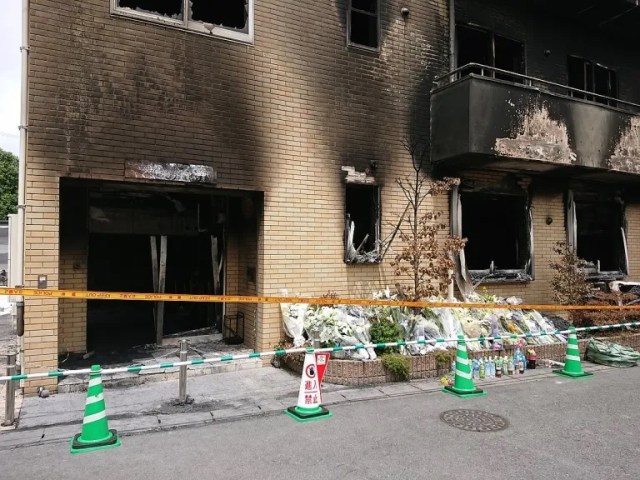
“There are no circumstances present for which the death penalty should be avoided.”
It’s been roughly four and a half years since Shinji Aoba walked into anime production company Kyoto Animation’s studio in the Fushimi district of Kyoto, spread gasoline around the interior, and set it ablaze. 36 Kyoto Animation employees were killed and another 33 injured, with only one of the 70 people in the building miraculously making it out unharmed.
Aoba’s guilt, in the sense of whether or not he was the person who committed the crime, has never been in doubt He was apprehended attempting to flee the scene after the flames engulfed his body as well, and has admitted that he purposely attacked the studio as an act of revenge for what he saw as plagiarism of a novel he had submitted to Kyoto Animation as part of a writing contest. The severity of Aoba’s burns, however, meant that considerable time would pass before he could be formally arrested (as he had to be deemed healthy enough to survive incarceration), and the pace at which his trial could proceed was limited in part due to his ongoing physical rehabilitation.
The trial has now concluded, though, and the Kyoto District Court, seeing no chance of Aoba’s mental and moral rehabilitation, has sentenced him to death.
The crux of debate during the trial was whether or not the now 45-year-old Aoba was of sufficient mental capacity to be legally punished for the arson attack. In addition to stating that he chose his method of attack specifically because he felt it would allow him to kill more people, throughout the trial Aoba maintained that he continues to feel that he has been wronged by Kyoto Animation, and displayed an utter lack of remorse when first learning how many people had died because of him.
In its ruling, the court cited Aoba’s deliberate decision to attack the studio early in the business day, when a large number of employees could be expected to be inside the building, and the premeditated nature of purchasing and transporting the large quantity of gasoline used to the scene of the crime, concluding “There are no circumstances present for which the death penalty should be avoided.”
Source: NHK News Web, Yahoo! Japan News/Yomiuri TV
Top image: Wikipedia/L26
● Want to hear about SoraNews24’s latest articles as soon as they’re published? Follow us on Facebook and Twitter.

 Appeal filed to block death sentence for Kyoto Animation arsonist
Appeal filed to block death sentence for Kyoto Animation arsonist Mental illness issues could make death penalty impossible for Kyoto Animation arsonist
Mental illness issues could make death penalty impossible for Kyoto Animation arsonist Death penalty formally requested for Kyoto Animation arsonist by prosecutors as trial closes
Death penalty formally requested for Kyoto Animation arsonist by prosecutors as trial closes Kyoto Animation arsonist’s psychological evaluation ends, open door to prosecution
Kyoto Animation arsonist’s psychological evaluation ends, open door to prosecution Hello, cosmetics! Clinique teams up with Hello Kitty this summer for first-time collaboration
Hello, cosmetics! Clinique teams up with Hello Kitty this summer for first-time collaboration Demon Slayer: Kimetsu no Yaiba gets new roller coaster attractions and food at Universal Studios Japan
Demon Slayer: Kimetsu no Yaiba gets new roller coaster attractions and food at Universal Studios Japan How to order snacks on a Shinkansen bullet train in Japan
How to order snacks on a Shinkansen bullet train in Japan High-fashion Totoro cuddle purse is like an elegant stroll in the forest【Photos】
High-fashion Totoro cuddle purse is like an elegant stroll in the forest【Photos】 Japan’s new difficult-to-drink-from beer glass protects your liver, but it’s a brutal experience
Japan’s new difficult-to-drink-from beer glass protects your liver, but it’s a brutal experience Kyoto Tower mascot termination reveals dark side behind cute Japanese characters
Kyoto Tower mascot termination reveals dark side behind cute Japanese characters Edible 10-yen coins become a hot new trend in Tokyo【Taste test】
Edible 10-yen coins become a hot new trend in Tokyo【Taste test】 Tsukiji Fish Market Vendor Releases Tuna For Home Assembly
Tsukiji Fish Market Vendor Releases Tuna For Home Assembly A visit to the best UFO catcher arcade in the universe!
A visit to the best UFO catcher arcade in the universe! New samurai glasses are Japan’s latest weird must-have souvenir
New samurai glasses are Japan’s latest weird must-have souvenir Nintendo history you can feel – Super NES, N64, and GameCube controllers become capsule toys
Nintendo history you can feel – Super NES, N64, and GameCube controllers become capsule toys “The most Delicious Cup Noodle in history” – Japan’s French Cup Noodle wins our heart【Taste test】
“The most Delicious Cup Noodle in history” – Japan’s French Cup Noodle wins our heart【Taste test】 Starbucks releases a cute Frappuccino and Unicorn Cake…but not in Japan
Starbucks releases a cute Frappuccino and Unicorn Cake…but not in Japan McDonald’s Japan’s Soft Twist Tower: A phantom ice cream only sold at select branches
McDonald’s Japan’s Soft Twist Tower: A phantom ice cream only sold at select branches Yabai Ramen: What makes this Japanese ramen so dangerous?
Yabai Ramen: What makes this Japanese ramen so dangerous? Finally! Nintendo Japan expands Switch 8-bit controller sales to everybody, Online member or not
Finally! Nintendo Japan expands Switch 8-bit controller sales to everybody, Online member or not Japanese government wants to build luxury resorts in all national parks for foreign tourists
Japanese government wants to build luxury resorts in all national parks for foreign tourists To combat declining birth rate, Japan to begin offering “Breeding Visas” to foreigners
To combat declining birth rate, Japan to begin offering “Breeding Visas” to foreigners 10 things you should buy at 7-Eleven in Japan
10 things you should buy at 7-Eleven in Japan Studio Ghibli releases anime heroine cosplay dresses that are super comfy to wear
Studio Ghibli releases anime heroine cosplay dresses that are super comfy to wear Woman charged for driving suitcase without a license in Osaka
Woman charged for driving suitcase without a license in Osaka Studio Ghibli unveils My Neighbour Totoro miniature house model
Studio Ghibli unveils My Neighbour Totoro miniature house model Kyoto experiencing problems with foreign tourists not paying for bus fares, but not on purpose
Kyoto experiencing problems with foreign tourists not paying for bus fares, but not on purpose Fighting mild hunger with a Japanese soda that turns into jelly in the stomach【Taste test】
Fighting mild hunger with a Japanese soda that turns into jelly in the stomach【Taste test】 Studio Ghibli’s Howl’s Moving Castle tapestry unveiled in Japan for first time
Studio Ghibli’s Howl’s Moving Castle tapestry unveiled in Japan for first time McDonald’s new Happy Meals offer up cute and practical Sanrio lifestyle goods
McDonald’s new Happy Meals offer up cute and practical Sanrio lifestyle goods Sales of Japan’s most convenient train ticket/shopping payment cards suspended indefinitely
Sales of Japan’s most convenient train ticket/shopping payment cards suspended indefinitely Sold-out Studio Ghibli desktop humidifiers are back so Totoro can help you through the dry season
Sold-out Studio Ghibli desktop humidifiers are back so Totoro can help you through the dry season Japanese government to make first change to romanization spelling rules since the 1950s
Japanese government to make first change to romanization spelling rules since the 1950s Foreigner’s request for help in Tokyo makes us sad for the state of society
Foreigner’s request for help in Tokyo makes us sad for the state of society Ghibli founders Toshio Suzuki and Hayao Miyazaki contribute to Japanese whisky Totoro label design
Ghibli founders Toshio Suzuki and Hayao Miyazaki contribute to Japanese whisky Totoro label design Doraemon found buried at sea as scene from 1993 anime becomes real life【Photos】
Doraemon found buried at sea as scene from 1993 anime becomes real life【Photos】 Tokyo’s most famous Starbucks is closed
Tokyo’s most famous Starbucks is closed Princesses, fruits, and blacksmiths: Study reveals the 30 most unusual family names in Japan
Princesses, fruits, and blacksmiths: Study reveals the 30 most unusual family names in Japan “Oh, is that so?” says Kyoto Animation arsonist when told how many people he killed
“Oh, is that so?” says Kyoto Animation arsonist when told how many people he killed Kyoto Animation comments on arsonist arrest: “Our friends whose lives were taken won’t come back”
Kyoto Animation comments on arsonist arrest: “Our friends whose lives were taken won’t come back” Kyoto Animation arsonist develops a soft spot for nurse treating him at hospital
Kyoto Animation arsonist develops a soft spot for nurse treating him at hospital Kyoto Animation arsonist to be finally placed under arrest for July attack that killed 36
Kyoto Animation arsonist to be finally placed under arrest for July attack that killed 36 Kyoto Animation arson attack prompts call for stricter gas sale regulations in Kyoto
Kyoto Animation arson attack prompts call for stricter gas sale regulations in Kyoto Kyoto Animation arsonist begins physical therapy, regains ability to speak
Kyoto Animation arsonist begins physical therapy, regains ability to speak Kyoto Animation arsonist’s lawyer says he doesn’t need to be in custody, investigators disagree
Kyoto Animation arsonist’s lawyer says he doesn’t need to be in custody, investigators disagree Kyoto Animation president wants to turn site of arson attack into memorial park for victims
Kyoto Animation president wants to turn site of arson attack into memorial park for victims Kyoto Animation arsonist will live, status upgraded by doctors
Kyoto Animation arsonist will live, status upgraded by doctors Kyoto Animation arsonist sent more than one novel to company as part of annual writing contest
Kyoto Animation arsonist sent more than one novel to company as part of annual writing contest Kyoto Animation arson attack leads Japanese government to develop stricter gas sale regulations
Kyoto Animation arson attack leads Japanese government to develop stricter gas sale regulations New arrest warrant issued for Kyoto Animation arson suspect
New arrest warrant issued for Kyoto Animation arson suspect Kyoto Animation accepting direct, individual donations for arson victims via special bank account
Kyoto Animation accepting direct, individual donations for arson victims via special bank account Anime studio attacked by arsonist, explosion leaves dozens injured, 12 dead
Anime studio attacked by arsonist, explosion leaves dozens injured, 12 dead “We will not go quietly into the night. We will not vanish without a fight,” vows Kyoto Animation
“We will not go quietly into the night. We will not vanish without a fight,” vows Kyoto Animation
Leave a Reply